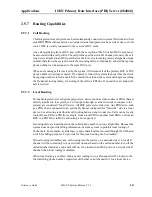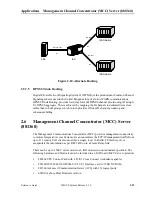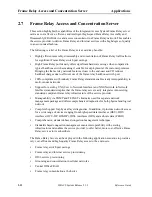
2-30
IMACS System Release 5.1.9
Reference Guide
Model No.
Running Head
Management Channel Concentrator (MCC) Server (881360)
Applications
•
63110 or 63120- MCC Server firmware
The following protocols are supported by the MCC:
•
Ethernet Media Access Control Protocol (MAC)
•
Address Resolution Protocol (ARP)
•
Internet Protocol, version 4. (IP)
•
Internet Control Message Protocol (ICMP)
•
User Datagram Protocol (UDP)
•
Routing Information Protocol (RIP)
•
Frame Relay (RFC1490)
The MCC provides management of remote IADs’ using TCP/IP and SNMP/UDP/IP through
the FDL bit of the ESF format if used for T1. For E1, management is provided through the
SA4 bit of the frame following the frame alignment word in time-slot 0. The MCC offers far
more interfaces and functionality than the B7R, thus replacing it, and the device used to route
between the asynchronous aggregate serial port and Ethernet.
MCC can be configured to use unnumbered or numbered interfaces. If unnumbered interfaces
are used, MCC is accessed through the global Ethernet address regardless of what interface is
used. If numbered interfaces are used, each interface has a local IP address. Unnumbered
interfaces help conserving IP addresses as only one address is used per interface. This
addressing method may not be compatible with HP Openview.
The MCC routes IP datagrams between all of its interfaces, based on each datagram's IP
destination address.
Datagrams are directed (or routed) to the interface carrying the sub-net to which the datagram
belongs or is being transported to, according to the content of the routing table. The routing
table may be supplied with dynamic routes from the Routing Information Protocol (RIP) when
enabled. If no match is found in the routing table, a default route can be designated to direct
all unresolved datagrams to a specific interface.
Initial configuration of the MCC can made through the local VT100 port. When a working
interface is established to the CPU hosting the MCC, subsequent configurations can be done
remotely via SNMP/TELNET. All configurable port parameters are permanently stored in
NV-RAM and downloaded to the card during startup. An interface card remains in standby
position until correctly configured and activated. Statistics are also available on both interface
cards.
IP-based management information from clients is typically provided to the MCC by a Digital
Access and Cross-connect System (DACS) as Bit Seven Redundant (B7R) or Bit Four
Redundant (B4R) DS0 channels on a T1 or E1 link. The MCC routes IP packets among the
131 available WAN interfaces, the local host CPU and Ethernet. Each interface represents a
separate network or subnet as specified by the IP address and Netmask combination. Three of
the 131 are high-speed interfaces that can either be configured as Nx64 kbps (N=1 to 24 for















































